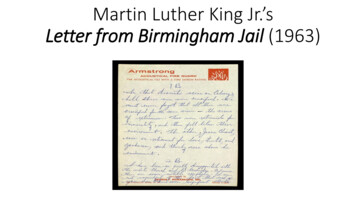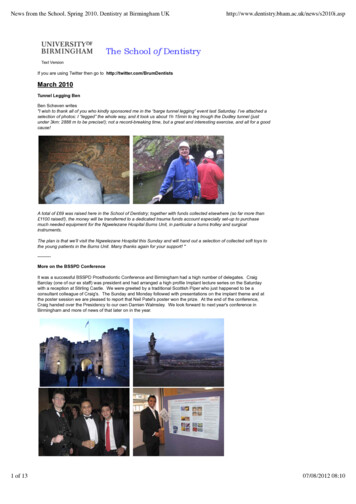Transcription
University of BirminghamThe thick target inverse kinematics technique with alarge acceptance silicon detector arrayWalshe, J.; Freer, M.; Wheldon, C.; Achouri, L. N.; Ashwood, N. I.; Catford, W. N.; Celik, I. C.;Curtis, N.; Delaunay, F.; Fernández-Domínguez, B.; Grassi, L.; Kokalova Wheldon, Tzanka;Marqués, M.; Orr, N. A.; Prepolec, L.; Scuderi, V.; Soi, N.; Toki, ve Commons: Attribution (CC BY)Document VersionPublisher's PDF, also known as Version of recordCitation for published version (Harvard):Walshe, J, Freer, M, Wheldon, C, Achouri, LN, Ashwood, NI, Catford, WN, Celik, IC, Curtis, N, Delaunay, F,Fernández-Domínguez, B, Grassi, L, Kokalova Wheldon, T, Marqués, M, Orr, NA, Prepolec, L, Scuderi, V, Soi,N & Toki, V 2014, 'The thick target inverse kinematics technique with a large acceptance silicon detector array',Journal of Physics: Conference Series, vol. 569, no. 1, 012052. https://doi.org/10.1088/1742-6596/569/1/012052Link to publication on Research at Birmingham portalGeneral rightsUnless a licence is specified above, all rights (including copyright and moral rights) in this document are retained by the authors and/or thecopyright holders. The express permission of the copyright holder must be obtained for any use of this material other than for purposespermitted by law. Users may freely distribute the URL that is used to identify this publication. Users may download and/or print one copy of the publication from the University of Birmingham research portal for the purpose of privatestudy or non-commercial research. User may use extracts from the document in line with the concept of ‘fair dealing’ under the Copyright, Designs and Patents Act 1988 (?) Users may not further distribute the material nor use it for the purposes of commercial gain.Where a licence is displayed above, please note the terms and conditions of the licence govern your use of this document.When citing, please reference the published version.Take down policyWhile the University of Birmingham exercises care and attention in making items available there are rare occasions when an item has beenuploaded in error or has been deemed to be commercially or otherwise sensitive.If you believe that this is the case for this document, please contact UBIRA@lists.bham.ac.uk providing details and we will remove access tothe work immediately and investigate.Download date: 06. Jun. 2021
HomeSearchCollectionsJournalsAboutContact usMy IOPscienceThe thick target inverse kinematics technique with a large acceptance silicon detector arrayThis content has been downloaded from IOPscience. Please scroll down to see the full text.2014 J. Phys.: Conf. Ser. 569 12052)View the table of contents for this issue, or go to the journal homepage for moreDownload details:IP Address: 147.188.40.113This content was downloaded on 23/12/2014 at 15:56Please note that terms and conditions apply.
3rd International Workshop on “State of the Art in Nuclear Cluster Physics”IOP PublishingJournal of Physics: Conference Series 569 (2014) 012052doi:10.1088/1742-6596/569/1/012052The thick target inverse kinematics technique with alarge acceptance silicon detector array11121J Walshe , M Freer , C Wheldon , L N Achouri , N I Ashwood ,3312W N Catford , I C Celik , N Curtis , F Delaunay ,4512B Fernández-Domínguez , L Grassi , Tz Kokalova , M Marqués ,25655N A Orr , L Prepolec , V Scuderi , N Soi and V Toki School of Physics and Astronomy, University of Birmingham, Birmingham, B15 2TT, UK.Laboratoire de Physique Corpusculaire de Caen, 6 bd Maréchal Juin, 14050 Caen, France3Department of Physics, University of Surrey, Guildford, Surrey, GU2 7XH, UK.4Universidade de Santiago de Compostela, 15782 Santiago de Compostela, Spain5Institut Ru er Bo²kovi , Bijeni ka cesta 54, 10000 Zagreb, Croatia6INFN - Laboratori Nazionali del Sud, via S.So a 62, 95125 Catania, Italy12E-mail: j.walshe@pgr.bham.ac.ukAn experimental technique for studying elastic scattering using a thick gas targetis described, with a measurement of the α(24 Ne,α) reaction used as an example. Advantagessuch as ease, detector e ciency, and the possibility of measuring the cross section at 180 inthe centre-of-mass are discussed. It is shown that a resolution of tens of keV is practical atzero degrees, and that the dominant contribution to the resolution for large angles is angularstraggling of the beam in the entrance window. The use of helium gas as the target allows directmeasurement of α-cluster states.Abstract.1. IntroductionTraditional methods of studying elastic nuclear scattering use thin foil targets, and the elasticallyscattered beam-like particles are identi ed by energy discrimination. Counting the events inthis elastic peak gives the cross section for a single centre-of-mass (c.m.) energy; in orderto construct an excitation function the beam energy must be changed and the measurementrepeated, often hundreds of times. While e ective, this method is only practical with relativelysimple accelerators most commonly tandem Van De Graa s and so experiments of this typeare limited by the beams available at such facilities. In particular, modern radioactive beamfacilities provide access to much new physics, but as the creation and acceleration of radioactivenuclei is typically a complex process the retuning of these beams can take several hours. Studiesusing these beams must then use a di erent technique.2. MethodThe thick target inverse kinematics technique, rst described in [1], allows continuousmeasurement of an excitation function using a single beam energy. The set-up of the targetchamber is shown in gure 1. In this work the target was helium gas, which lled the chamberand is described as thick because the pressure is tuned such that the beam is stopped within theContent from this work may be used under the terms of the Creative Commons Attribution 3.0 licence. Any further distributionof this work must maintain attribution to the author(s) and the title of the work, journal citation and DOI.Published under licence by IOP Publishing Ltd1
3rd International Workshop on “State of the Art in Nuclear Cluster Physics”IOP PublishingJournal of Physics: Conference Series 569 (2014) amber.2.Calculation of the kinematicsand energy loss allows reconstruction of thereaction from the detected particle energy.FigureSchematic of the experimentalgas volume. A thin window, in this case a 5 µm Havar foil, separated the gas from the beam line.A beam of 24 Ne with an energy of 3.8 MeV/A and intensity of 3 105 pps was provided by theSPIRAL facility at GANIL. As the beam is stopped in the target, nuclear reactions take placeover a continuous range of energies with the maximum de ned by the beam energy immediatelyafter the window and the minimum limited only by Rutherford scattering. While reactions areproduced simultaneously over this energy range, it is useful to note that each c.m. energy islocalised to a point in the chamber.In a thick target experiment, the detected particles must be lighter than the beam nuclei toescape the target gas and reach the detectors. Normally, experiments are performed in inversekinematics where the beam nuclei are heavier than the target nuclei, and the target-like particlescan be detected. An important feature of this method is that the scattered light particlesare con ned to forward angles in the laboratory (for elastic scattering), which means that thee ciency of appropriately positioned detectors is doubled. In addition, as the beam is absorbed,a detector can be placed at zero degrees in the laboratory, corresponding to 180 in the c.m.frame; at this point the Rutherford scattering cross-section is at a minimum and the resonancescattering cross-section is maximal.The detector array is placed within the gas volume such that the beam does not reach thedetectors but the scattered target-like particles do. In the current work the array consisted rstlyof a square double-sided silicon strip detector at zero degrees with 256 pixels, each 3 mm square.In addition, a lampshade' array of six wedge shaped silicon detectors (Micron YY1 design[2])captured events at large angles. These detectors were single sided, with 16 curved strips eachcovering an approximately constant polar angle range. The lampshade provided full azimuthalcoverage, and the maximum θ measured was at least 44 in the c.m. frame, increasing to fullcoverage for lower energy events that take place closer to the array. Finally three additionalHavar foils, each 2 µm thick, were available upstream of the window to allow the beam energyto be easily reduced in approximately 10 MeV steps.3. Data reconstructionIn a thin target experiment the c.m. interaction energy can be straight forwardly reconstructedkinematically from the energy of the beam. For a thick target experiment, the energy of thedetected particle is used but the energy loss of the beam and target through the gas must be2
Counts per 10 keV3rd International Workshop on “State of the Art in Nuclear Cluster Physics”IOP PublishingJournal of Physics: Conference Series 569 (2014) ructed600Generated (/100)500400300200100014171615Excitation energy (MeV)18Simulated excitation function for 28 Mg using REX. (left) The zero degree detectorshowing (red) input data reduced by a factor of 100 and (black) reconstructed data. (right) Theentire array.Figure 3.taken into account. Figure 2 shows a calculation for the 24 Ne α reaction, which can be used tond the properties of the interaction from only the energy of the detected α particle. However,in order to do this reconstruction, elastic scattering must be assumed there is no way todistinguish elastic and inelastic events using only one beam energy. It is known though that thevery highest energy events must be elastic; by leaving one of the reaction nuclei in an excitedstate a known minimum amount of energy must be removed from the available kinetic energy. Inthe case of 24 Ne α, the rst excited state of 24 Ne is at 1.98 MeV, so events within this energy ofthe maximum of the spectrum must be elastic. Then, by stepping the beam energy down (usingadditional Havar foils as described above) a larger clean' region can be produced.4. Experimental characteristicsA new in-house Monte-Carlo code, the Resonant Excitation Function Simulation (REX), wasused to simulate the experiment and identify the e ects that contribute most to the resolutionand e ciency of the data. This code generates events using a given excitation function andincludes all of the experimental e ects such as energy loss, energy and angular straggling, andthe geometry of the detector array. The output is a list of detected events that can be analysedin the same way as experimental data in order to test the reconstruction method.Figure 3 shows how well the true excitation function simulated using REX can be reconstructedusing the method outlined above. The input parameters for the simulation were three states in28 Mg at 15, 16 and 17 MeV, with widths of 100, 10 and 1 keV respectively; the detector setup was identical to the experiment as described above with a 24 Ne beam. The reconstructedwidths were 147, 70 and 68 keV. As the measured peak width does not change for the 1 and 10keV peaks this minimum width represents the overall resolution of the method, approximately70 keV FWHM. Importantly, this is better than the intrinsic energy resolution of the silicondetectors. The transformation of the data into the c.m. frame improves the resolution by afactor of approximately 3.5, and this e ect scales with the c.m. velocity so that for heavierbeams the resolution will be better.Figure 3 also shows the data from the same simulation including the data from the lampshadearray. The detected α-particle energy is plotted against the angle of the strip with respect to theentrance window (i.e., these data are shown in the laboratory frame). The kinematic fall-o ofthe angular distributions can be seen, as well as the change in resolution with angle. Examinationof the simulations reveals the reason for the latter e ect. A number of factors are involved, but3
3rd International Workshop on “State of the Art in Nuclear Cluster Physics”IOP PublishingJournal of Physics: Conference Series 569 (2014) al data forthe entire detector array.The e ects of angular and energystraggling. See text for details.Figure 5.Figure 4.28 Mgfromthe most important are energy and angular straggling of the beam caused by the entrance windowand, to a lesser extent, the gas, as shown in gure 4. Events for a given c.m. energy, which cannominally be associated with a given depth in the gas, can in fact take place within a nite area,denoted roughly by the dashed circle. Points 1 and 2 represent two extremes. For events in thezero degree detector the scattering angle, θ, varies only a small amount, and thus the resolutionis best in this detector. For the lampshade, however, the range of scattering angles availablefor a given c.m. energy and a given detector strip is large, and so there is signi cant kinematicbroadening of the data.For a 24 Ne beam at 90 MeV passing through 5 µm of Havar, the energy loss is approximately 20MeV with 100 keV of straggling. This corresponds to a position straggling in the beam directionof the order of millimetres. The angular straggling after the window is approximately one degree,which produces a position straggling perpendicular to the beam direction approaching 5 mm forlow energy events. Thus the angular straggling is the dominant contributor to the resolution ofthe array at large angles.5. DataFigure 5 shows experimental data taken using this technique for the α(24 Ne,α) reaction. As inthe simulated data, states are seen as lines in the zero degree detector, wi
The thick target inverse kinematics technique with a large acceptance silicon detector array J Walshe 1, M reeFr 1, C Wheldon 1, L N Achouri 2, N I Ashwood 1, W N Catford 3, I C Celik 3, N Curtis 1, F Delaunay 2, B ernández-DomínguezF 4, L Grassi 5, zT Kokaloav 1, M Marqués 2, N A Orr 2, L Prepolec 5, V Scuderi 6, N Soi 5 and V oki T 5 1School of Physics and Astronom,y University of .



![Letter from Birmingham Jail (1963) [Abridged]](/img/2/1963-mlk-letter-abridged.jpg)







